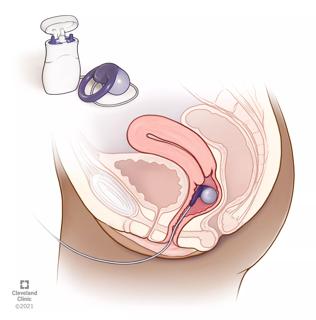Advertisement
Analysis suggests association between prior PARP inhibition and subsequent decreased progression-free survival in platinum-sensitive ovarian cancer

Ovarian cancer is a chemo-sensitive disease. Approximately 20 percent of patients with ovarian cancer have a hereditary germ-line mutation in the Fanconi Anemia-BRCA pathway. This not only increases the risk of ovarian cancer, but also improves their response to chemotherapy, explains Cleveland Clinic physician Peter Rose, M.D., first author of a recent study on PARP inhibitors and subsequent platinum-based chemotherapy in recurrent ovarian cancer.
Advertisement
Cleveland Clinic is a non-profit academic medical center. Advertising on our site helps support our mission. We do not endorse non-Cleveland Clinic products or services. Policy
“An additional 30 percent of the patients with the most common type of ovarian cancer — high grade serous carcinoma — may also have somatic (tumor) mutations, which increases the likelihood of responding to chemotherapy,” says Dr. Rose.
Currently, the standard initial chemotherapy treatment for ovarian cancer includes platinum-based agents. Patients who originally present with advanced stage III/IV disease develop recurrent cancer 70-80% of the time.
If disease progression occurred more than 6 months after their last platinum-based therapy, a patient was considered potentially platinum-sensitive, and platinum based therapy is the most active treatment in this setting. The platinum-free interval is defined as the time from the date of last platinum-based chemotherapy to the date of subsequent disease progression. The longer the platinum-free interval the greater the likelihood of response.
In addition to the platinum-free interval, the BRCA mutational status affects response to retreatment and is most effective in those patients with BRCA mutations.
“Patients with BRCA mutated ovarian cancer may potentially respond multiple times to a platinum-based chemotherapy regimen. We have patients with germ-line BRCA-like mutations who have had 9 complete responses to platinum over the last 17 years and are now disease-free,” Dr. Rose says.
Poly-adenosine ribose phosphatase (PARP) enzymes play an important role in the repair of single-strand DNA breaks and maintenance of the genomic integrity of a cell. Recently, PARP inhibitors have gained broad approval for the treatment of patients with epithelial ovarian cancer (EOC). However, they suppress the bone marrow and are associated with anemia, low platelets and bone marrow diseases, including myelodysplastic syndrome and acute myeloid leukemia.
“While PARP inhibitors were initially approved only for patients with a germline and subsequently somatic BRCA mutation, current approvals based on improved progression-free survivals allow for PARP inhibitors as primary maintenance therapy following first-line chemotherapy and as secondary maintenance following platinum sensitive recurrence, irrespective of BRCA mutational status,” notes Dr. Rose. “We also do not have the data on the effect of the PARP inhibitors on overall survival and their long-term toxicity.”
Following observed poor response of BRCA-mutated patients with prior PARP inhibitors exposure to subsequent platinum based chemotherapy, an IRB retrospective study was designed to evaluate all ovarian cancer patients treated with PARP inhibitors for ovarian cancer at Cleveland Clinic. Since response to subsequent platinum-based therapy is higher among BRCA-mutated EOC, Dr. Rose and colleagues initially analyzed BRCA-mutated EOC patients who did or did not undergo PARP inhibitor therapy before their second or third platinum-based chemotherapy.
Advertisement
The study, conducted by a team of Cleveland Clinic researchers, demonstrated that PARP inhibitor therapy significantly reduced progression-free survival following subsequent platinum-based chemotherapy.
Patients were categorized by their BRCA mutation status, and the researchers studied a control population of BRCA-mutated EOC patients who received second- or third-line platinum-based chemotherapy without PARP inhibitor exposure. They reported that 115 platinum-sensitive BRCA-mutated patients were administered a second-line platinum-based agent; 108 of those were PARP inhibitors naïve. Data showed that the median progression-free survival was 2.4 times longer following a patient’s second platinum-based chemotherapy when they did not receive a PARP inhibitor.
Of the 55 BRCA-mutated patients who received a third platinum-based chemotherapy, 42 had not been given a PARP inhibitor. For this group of patients, the median progression-free survival was 2.3 times longer for those who were PARP inhibitor naïve.
“Among patients with BRCA-mutated EOC, we observed that the progression-free survival to subsequent platinum-based chemotherapy was significantly reduced to 8 months following a PARP inhibitor compared to 19.1 months for PARP inhibitor naïve,” Dr. Rose notes.
Among BRCA-mutated patients following PARP inhibitor exposure, the platinum-free interval was not predictive of progression-free survival. The research team also studied 49 patients — 29 BRCA-mutated and 20 BRCA-wild type — who had received platinum-based chemotherapy after undergoing treatment with a PARP inhibitors.
The authors also found that prior PARP inhibitor exposure nullifies the effect of BRCA mutational status, in platinum-sensitive recurrent ovarian cancer. These findings, recently published in the journal Anti-Cancer Drugs, suggest that caution and further study is warranted regarding the use of PARP inhibitors among patients with ovarian cancer.
Dr. Rose and colleagues initiated this retrospective, single-institution cohort study to understand the effect of PARP inhibitors on subsequent platinum-based chemotherapy response among patients with recurrent, platinum-sensitive BRCA-mutated epithelial ovarian, peritoneal or fallopian cancer.
The researchers used computerized records to identify EOC patients who received a PARP inhibitor — niraparib, olaparib, rucaparib or veliparib — for more than 30 days and subsequent platinum-based chemotherapy. They found that PARP inhibitor exposure significantly reduced the progression-free survival with subsequent platinum-based chemotherapy.
Advertisement
Furthermore, PARP inhibitor exposure negated the importance of the platinum free interval and the BRCA mutational status with respect to likelihood of response. This may explain why PARP inhibitors significantly prolong the progression-free but not overall survival.
Advertisement
Advertisement

Trial examines novel approach for a disease with a high mortality rate

Studying trends of conization with lymph node evaluation, trachelectomy and radical hysterectomy

Study showed that regimen was well-tolerated in cohort with aggressive carcinoma

Research helps identify patients who might benefit from adjuvant therapies

Device provides alternative to conservative management and surgical procedures

Study finds 10-month survival difference

Caution warranted when prescribing antibiotics to these patients

Announcing the Lilli and Seth Harris Endowed Chair for Ovarian Cancer